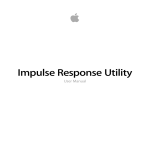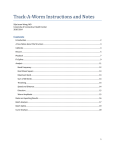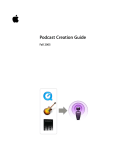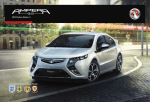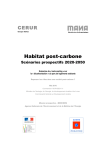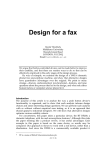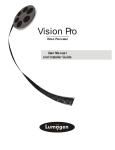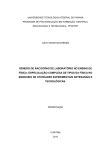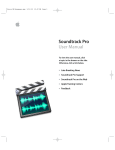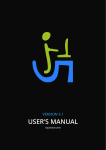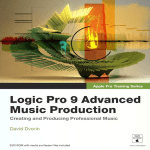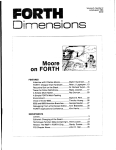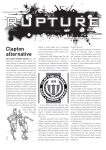Download Driver`s Preference Towards In
Transcript
CHALMERS UNIVERSITY OF TECHNOLOGY Driver’s Preference Towards In-Vehicle 3D Sound Driving Assistance System Master of Science Thesis in the Programme Interaction Design DONG SUN Department of Applied Information Technology CHALMERS UNIVERSITY OF TECHNOLOGY Gothenburg, Sweden, 2012 Report No. 2012:090 ISSN: 1651-4769 CHALMERS UNIVERSITY OF TECHNOLOGY Driver’s Preference Towards In-Vehicle 3D Sound Driving Assistance System Dong Sun Report No. 2012:090 ISSN: 1651-4769 © DONG SUN, 2012. Examiner: FANG CHEN Chalmers University of Technology Department of Applied Information Technology SE-412 96 Göteborg Sweden Telephone + 46 (0)31-772 1000 Department of Applied Information Technology Göteborg, Sweden October 2012 2 CHALMERS UNIVERSITY OF TECHNOLOGY ACKNOWLEDGMENT Firstly, I would thank my examiner, Professor Fang Chen offers me such a great opportunity to take this project. Next, I would present my greatest thank to my supervisor Min. With her, there always a lighthouse bright the path, guiding me and brings so much encourage to me during those difficult time. I would also thank Sijie, my best friend, as always, watch my back. Also, special thank to lecturers and staffs of Chalmers, colleague in Safer, for all your sincerely supports. Finally, I would thank my parents, you gives me life, let me educated, hope soon I shall proud both of you. 2011.04 midnight in Göteborg 3 CHALMERS UNIVERSITY OF TECHNOLOGY ABSTRACT Most of the traffic related information of current active safety system transit to driver by Advanced driving assistance system (ADAS). These informations mainly represented as warning signal, and normally activated in potentially dangerous, near-crash or pre-crash situation and driver is incapable to make right decision due to the very short trigger time; present studies shows that increasing the driver’s awareness to traffic related information is an efficient method to improve road safety. Some initial researches already shown the potential benefits of using Three-dimensional (3D) sound information for enhance traffic environment awareness and human-machine interaction (HMI), by introducing designed In-Vehicle Information Systems (IVIS), the 3D sounds ADAS, the drivers can understand intuitively such as the type of the road user, the distance between driver and the movement course of objects, etc. Yet, to have an ergonomic design, to understand drivers’ behaviors and needs in drive context is the most priority work. The purpose of this study is to bring a real traffic context in terms of 3D sound and traffic video records into the design process, build up an dynamic communication tool for drivers and designers in order to involve both parties in the same context and enhance a better communication. In this study, a simulated 3D sound traffic experimental environment has been programmed, where the participants watched the traffic movie record filmed on real road while hearing the real time 3D sound which synchronized with. Focus group has been facilitated as an experimental tool for enabling the discussions and evaluating ideas and perspectives towards to 3D sound. In addition, two types of sound have been designed and put into the simulated 3D sound environment: abstract sound and natural sound. The main task include recreate virtual traffic environment in SFAER’s simulation room, designing four sets of different driving situation scenario with real traffic video clip which taken in China and Sweden; further, assess the effectiveness of 3D sound ADAS in purpose of represent the traffic information, for instance, represent the variety objects on the road through nature or abstract sound, as the meaning of increasing driver’s awareness of the traffic and driving status, reducing workload and bring an overall benefit in terms of road safety. Keywords: Active Safety, Advanced Driving Assistance System (ADAS), 3D Sound, Human-Machine Interaction (HMI), In-Vehicle Information Systems (IVIS) 4 CHALMERS UNIVERSITY OF TECHNOLOGY CONTENTS ACKNOWLEDGMENT..............................................................................................I ABSTRACT..................................................................................................................II 1. INTRODUCTION ...................................................................................................7 1.1 Background .........................................................................................................7 1.2 Objective .............................................................................................................8 2. LITERATURE RESEARCH ..................................................................................9 2.1 3D Information Interface in Aircraft Cockpits....................................................9 2.2 3D/Multi-channel Audio System.........................................................................10 2.3 Advanced Driver Assistance Systems (ADAS) ..................................................11 3. CONCEPTUAL DESIGN .......................................................................................13 3.1 Traffic Video Record Selection ...........................................................................13 3.2 Auditory Message Design ...................................................................................16 3.2.1 Natural Sound..............................................................................................16 3.2.2 Abstract Sound ............................................................................................17 4. IMPLEMENTATION PROCESS ..........................................................................19 4.1 Hardware .............................................................................................................19 4.1.1 5.1 Multi-Channel System...........................................................................19 4.1.2 Indoor Soundproofing..................................................................................20 4.1.3 Hardware Component .................................................................................22 4.1.3.1 M-audio ProFire 610 Audio Interface .......................................................22 4.1.3.2 Logitech Z-5500 ........................................................................................23 4.1.3.3 Sound Reflection Absorbing Fabric ..........................................................24 4.2 Software ..............................................................................................................25 4.2.1 Audio Interface Control Panel .....................................................................25 4.2.2 Soundtrack Pro ............................................................................................26 4.2.3 Scenario Documents Making.......................................................................27 5. EXPERIMENT DESIGN ........................................................................................30 5.1 Experimental Subjects ........................................................................................30 5.2 Scenario...............................................................................................................31 5.3 Simulation Room Facilities.................................................................................34 5.4 Data Gathering Methodology .............................................................................37 5.5 Experiment Procedure .........................................................................................39 5 CHALMERS UNIVERSITY OF TECHNOLOGY 6. DATA ANALYSIS ....................................................................................................40 6.1 Audio Preference .................................................................................................40 6.1.1 Auditory Message Mapping Effectiveness ..................................................40 6.1.2 Auditory Message Quality ..........................................................................42 6.1.3 Auditory Message Acceptance ....................................................................43 6.1.4 Audio Type Preference ................................................................................45 6.2 Traffic Information Preference............................................................................46 6.2.1 Expression of Traffic Related Information..................................................46 6.2.2 Requirement of Traffic Related Information ...............................................47 6.2.3 Priority of Attribute of Traffic Related Information....................................48 7. CONCLUSION & DISCUSSION ..........................................................................49 8. LIMITATION & FUTURE WORK.......................................................................51 REFERENCE...............................................................................................................52 APPENDIX 1: Questionnaire .....................................................................................54 APPENDIX 2: Example of Experimental Script ......................................................66 6 CHALMERS UNIVERSITY OF TECHNOLOGY 1. INTRODUCTION The evolution progress of automotive safety somehow illuminate the development of automotive industry, also, increased vehicle safety issues become the key approach that directly effected nowadays’ traffic environment. Passive safety improvement is one way of solution: highly rigid suspension, endergonic body structure, and airbag system, all these passive safety system are mainly rely on mechanical and industrial; meanwhile, they all aim on the moment of near-crash or crash situation. Active safety arise as a superstar recent years in domain of automotive safety. Since human fact can not be ignored in these kind of research, promote the driving safety in order to avoid crash or near-crash moment occurred by research on driver behavior and needs become an alternative solution. Advanced driving assistance system (refer as ADAS later on) is one representative of active safety, and has been scientifically proved that it could increasing driving safety sufficiently. Yet, as generally acknowledged, the key issue - HMI (human machine interaction)[1], the bridge which connect vehicle information system, vehicle control strategy, and the people, still need to be improved. Thus, the objective of this study is by take a user study and elicit user’s requirements of one particular system in purpose of lay the foundation for future design work: Threedimensional (3D) sound driving assistance system. The three-dimensional sphere of human hearing can be virtually achieved with audio channels that surround the listener. 3D audio systems provide the impression that sounds emanate from different positions within physical space, it normally established by a multi-channel system, which also well known as surround sound system. The surround sound encompasses a range of techniques such as for enriching the sound reproduction quality of an audio source with audio channels reproduced via additional speakers. Surround sound is characterized by a listener location or sweet spot where the audio effects work best, and presents a fixed or forward perspective of the sound field to the listener at this location. To that end, the multichannel surround sound application encircles the audience with surround sound. [2] 1.1 Background The history of ADAS could trace back to the mid 1980s or even early, one of the most widely known system by the public is the Antilock Braking System (ABS), which designed to keep a vehicle’s wheels from locking during a hard braking. In 2001, Carsten and Nilsson distinguish ADAS to four broad types. The first type contains InVehicle Information Systems (IVIS) that are intend to provide information beyond that available from the road and traffic environment. Then there are systems that provide warnings or feedback to reduce driver errors or violations. The third category includes systems that intervene with the driver’s control of the vehicle in purpose of increase 7 CHALMERS UNIVERSITY OF TECHNOLOGY driving comfort and safety. Finally there are automated systems that may increase road capacity, improve safety and free the driver to handle other tasks.[3] There are numerous ADAS mature product already available on the commercial market, also, more systems in different phases of development. The research of this study is based on first two types of systems, information systems and systems which providing warnings and feedback to the drivers, through user study in a virtual traffic environment simulation, in order to assess the impact between the systems and driver’s driving behavior. 1.2 Objective Visual interaction has been involved into the most of IVIS, but acoustical still stand at the stage of limited assist visual interaction yet. In perspective of explore more potential contribution of acoustical on ADAS, a concept of enhance driver’s awareness to traffic environment by using 3D sound has formulated, which generally around following concerns: • How to represent objects in traffic through 3D sound? • How will the 3D sound system perform during distinction traffic situations? • How to select and prioritize what information should presented? The result of the study shall gives answer of preferences of participants with the following issues, which the data of them may helpful for later researches: • • • • The road objects that willing to be presented from drivers’ perspective. The attributes of road objects should be presented from drivers’ perspective. The way of using 3D sound. The sound type that most preferred. 8 CHALMERS UNIVERSITY OF TECHNOLOGY 2. LITERATURE RESEARCH Solid theory foundation is assurance of entire study, in order to get a roundly understanding to relative domain, research and analysis has been carried on related products, projects and up-to-date technology solutions. 2.1 3D Information Interface in Aircraft Cockpits The development and implementation of 3D information interface has been carried out in aviation and astronautical industry at the beginning. Several organizations, including the NASA and FAA, have sponsored numbers of research projects into the use of spatial audio as a means of improving warnings in commercial aircraft. Other research groups, including the Australian Defense Science and Technology Organization, have explored the use of these techniques within military aviation. Existed study from C.W. Johnson and W. Dell shows that pilots ignored, and then became irritated with the various bells, whistles and voices that warned them of low fuel or similar emergency situations. But when a representative sound came from beneath them, they responded correctly. Figure 2.1 shown the response time due to distinction audio type. And the 3D sound concept is now being applied to teleconferencing applications at the Lab.[4] Figure 2.1: Learnability of the Stereo and 3D Simulations 9 CHALMERS UNIVERSITY OF TECHNOLOGY 2.2 3D/Multi-channel Audio System Another name of multi-channel audio system which well-known by the public is “Surrounding sound system”. Each speaker carries different sounds, and together they create the cinematic environment in the room. All these let listeners in the middle of action that the way of stereo audio system can not achieve. Further, there are several proposed benefits of such systems. Ideally, it should be possible for people to selectively attend to audio information from particular locations within 3D space. This supports the everyday filtering that people use to attend to a single speaker in a crowded room. Conversely, it should also be possible to monitor several different channels of information from audio sources in different positions. This resembles the everyday experience of listening to several different conversations at once without attending to one in particular.[4] Home Theater 5.1 system is the common title for the 6 channel surrounding sound systems, it is considered "standard" or "traditional" surrounding sound as it is the most commonly used in home theater. It uses five full-bandwidth channels with 3-20,000 Hz frequency, plus one "low frequency effects" (LFE) subwoofer channel with frequencies from 3-120 Hz.[5] Figure 2.2: Home Theater [6] Figure 2.2 is a demonstration of common home theater system. Front speakers should preferably be placed at the height of the ears of a seated listener. The rear (surround) speakers must be positioned slightly above this height. Left front and right front speakers placed on each side of the television set, both at the same distance. In practice, they should each form a 25° to 45° angle with the listener. The optimal position for the rear speakers is a short way back from the listener, forming a 90° to 110° angle with 10 CHALMERS UNIVERSITY OF TECHNOLOGY him/her. The central speaker must be placed directly above or below the TV set, as it is usually primarily used to relay the main actors' dialogue. The subwoofer may be placed anywhere in the room, but preferably on the ground, so as to better transmit the vibrations. Cinema In cinema condition of multi-channel audio system, surround speaker arrays will be applied instead of the limited numbers of surround speakers in 5.1, 6.1 or 7.1 surrounding sound systems, since the listening angle is less predictable in this kind of environment, another consideration is in order to gain the enough sound effect in such vast spaces. Figure 2.3 is a demonstration of multi-channel audio system arrangement for a small cinema environment. Figure 2.3: Cinema [7] 2.3 Advanced Driver Assistance Systems (ADAS) Advanced Driver Assistance Systems have the function of actively assisting the driver in avoiding accidents by providing information about current and upcoming traffic situations and helping the driver take proper action before a potential accident occurs. As the research described in this paper including evaluation focused on ADAS, therefore it should be useful for readers to understand what those systems do and what types of ADAS actually are or will be available on the commercial market within a few 11 CHALMERS UNIVERSITY OF TECHNOLOGY years. Learning relevant technologies should helpful in developing work to similar concept. Some typical and popular ADAS introduced given as example below:[8] Adaptive Cruise Control (ACC) Through the use of radars, adaptive cruise control aids driver safety by automatically accelerating, decelerating or maintaining your car’s current speed relative to vehicles around you. This ensures you keep a safe distance from other vehicles at all times and helps minimize the risk of an accident. Blind spot Detecting (BSD) Blind spot detecting system is a vehicle-based sensor device that detects other vehicles located to the driver’s side and rear. Warnings can be visual or audible. Increased warnings indicate potentially hazardous lane changes. Lane Departure Warning (LDW) LDW help driver keep the vehicle within the lines of his current lane. Driver will be alerted if he change lanes while going faster than a certain speed and without using turn signal, to protect against accidental drifting. 12 CHALMERS UNIVERSITY OF TECHNOLOGY 3. CONCEPTUAL DESIGN The concept design is one of most significant part of this project, as long as it has been formulated, all other following work such as hardware implementation, software programming can be carried out next, the detailed experimental process shall be decided , as well as the rest of works. Accordingly, the scenario design of the project should strictly drive by the aimed research objective where they have been mentioned in first phase. Thus, the proper work sequence would be design scenario based on the traffic video record, after that, find out the auditory messages to fit the traffic objects in those videos, further, the selected video and audio messages shall be integrated into 3D sound experimental environment at the implementation session. However, both of video and auditory messages collection work are treated as equally importance. 3.1 Traffic Video Record Selection There are totally 77 raw traffic video records in the database where taken under variety road type in Dalian, China at 2008. The videos were taking by a camera where mounted on the front top of the vehicle, each video contains one or more traffic events, also, one or more traffic objects involved randomly, and the length of the records lasts from less than a minute to more than 5 minutes. After all the videos have been watched, they have been categorized by road type, diverse parameter inside the video have been analyzed simultaneously. A scale list has been drawn, and a example shown in figure 3.1, Figure 3.1: Video Record Analysis List 13 CHALMERS UNIVERSITY OF TECHNOLOGY Further, following principles have been made in order to regulate the selection process: • The selected video should covers traffic situations that commonly seen by the public. Meanwhile, the feasibility shall be considered, which means even the purpose of the scenarios are intend to represent different driving situation as many as possible, but the outcome from excessively complex video might be meanness under this level of experimental criterial. • The content of video should combined by diversity road type as well as traffic related information. For instance, the road user might included vehicle, motorcycle, and pedestrian etc. And the video records must contain more than one type of traffic objects, since prioritize traffic objects is one major issue in this research. • The duration of experiments should be taken in consideration, therefore the total length of selected video should not exceed planning time, which the experiment for each group should be less in 2 hours. With the regulations, 4 video records have been selected eventually, and they will be used to represent 4 different traffic environment scenarios. Figure 3.2 is a set of screen shots of the video records, which represented several typical moment in everyday’s traffic environment. Figure 3.2: Screenshot of Video Records 14 CHALMERS UNIVERSITY OF TECHNOLOGY Further analysis work have been taken towards to those selected video records. Table 3.1 shown some major information of those videos, table 3.2 gives the detailed information of traffic events which appeared in those videos. Please note that passive situation emphasize the way of information represented, and active situation emphasize the type of information should represent. Table 3.1: Video Record Specification No Name Length Road Type Objects Shall Represent by Sound I Highway 20s Highway Vehicle II Roundabout 26s City, Roundabout Vehicle, Bicyclist, Motorcycle III Community 25s Community Path Pedestrian(moving and standing) IV City 19s City, Public road Bicyclist, Vehicle Table 3.2: Typical Traffic Situation No Type Passive Vehicle in opposite lane, Other vehicle approaching, Overtaken by other vehicle, Lane occupied by other vehicle Active Following front vehicle, Overtake other vehicle, Lane change, Blind spot Passive Vehicle in opposite lane, Bicyclist approaching zebra crossing, Vehicle across collision course Active Following front vehicle, Overtake motorcycle, Enter roundabout, Exit roundabout, Blind spot Passive Pass a vehicle parked on road shoulder, Pedestrian across the collision course Active Overtake pedestrian, Enter T-junction, Blind spot Passive Bicyclists across the collision course, Other vehicle approaching, Overtaken by other vehicle Active Overtake Bicyclists, Enter main road through ramp, Blind spot I II III IV Traffic Situation 15 CHALMERS UNIVERSITY OF TECHNOLOGY 3.2 Auditory Message Design “How to represent objects in traffic through 3D sound, what kind of sound can be used?” This question is the rudder and guidance of the auditory message design work. The sound type that used into scenarios must be cautiously thinking, since there were numerous of audio type existed, by discussion with project supervisor and advisor, basic guidelines have been made to assist auditory message design process: • As simple as possible. For instance, start with sound type that people familiar with, since it is better for project’s subjects to study and understand the system much more quickly. • Use extremely divers audio type in same scenario in order to find out how these difference will influence the reflection from subjects. • The auditory messages should compatible with the video record as well as they must suitable with the current level of criteria of this study. In another word, the auditory messages must be easy to reform, modify, and adjust. • In additional, diverse attributes of traffic objects must be noticed, even to same type of objects. For example, stopped pedestrian and the one in movement. Two type of sound have been chosen by the principle mentioned above: Natural sound and Abstract sound. Unlike the video selection session, there is no such a similar raw database of auditory messages provided yet, so all of the auditory messages are either collected from the Internet or Adobe free license auditory message database[9], and they shall fit to the project after modify and refine. The purpose of choose these two sound type is intend to measure people’s distinction preference to sound type, and to find out how the differences inside might affect people’s opinion to the system. Moreover, when the extreme situation comes like several vehicles appears at same time, in case to avoid people’s hearing confusion and inaccuracy, two similar but with nano distinction sound message will be synchronized on those objects separately. 3.2.1 Natural Sound “Natural sounds include animal sounds, from the chirruping of crickets to the vocalizations of mammals. They also include the sounds of other natural phenomena, such as water sounds”[10]. This is the definition to traditional natural sound. But here, in this study, it means the sound that generate naturally by particular object, thus to let people be able to reflect the exact object form immediately which correspond with the sound once they hearing it. The natural sound message contains natural meaning here, but sound itself could be artificially. 16 CHALMERS UNIVERSITY OF TECHNOLOGY There are totally 7 natural sound messages which are original from the Adobe free license auditory message database, the general specification of them are: • Sample rate: 48kHz • Bit Depth: 16 bit • Channels: Stereo And all of them shall be refined either on length or tone level in order to match the traffic object in videos better. Table 3.3 represent the more specification of these auditory message. Table 3.3: Natural Auditory Message Table No Name Possibly Correspond Objects Sample Rate Bit Depth Channel 1 Engine_1 Vehicle 48kHz 16 bit Stereo 2 Engine_2 Vehicle 48kHz 16 bit Stereo 3 Car passing Vehicle in opposite lane 48kHz 16 bit Stereo 4 Harley davidson Motorcycle 48kHz 16 bit Stereo 5 Belling Bicyclist 48kHz 16 bit Stereo 6 Human whistle Pedestrian (stopped) 48kHz 16 bit Stereo 7 Footstep pedestrian 48kHz 16 bit Stereo 3.2.2 Abstract Sound There is no such a officially definition to describe the abstract sound that applied here. However, regarding to the collection principle which mentioned above as well as concerning the initial purpose of auditory message design work, the word “abstract” is define the impression that those kind of sound gives people rather than describe the sound itself. The sound itself could be artificial sound, sort of warning sound, even mix of music, but “less meaning” should be the proper key issue of all these messages, in another word, the sound could match the rhythm or the frequency rather than brings any directly reflection to particular thing when subjects hear them. The reason to applied this kind of sound is because the study want to investigate how fast people could mapping the non-sense sound to particular traffic object, will this way be better than the natural ones? 17 CHALMERS UNIVERSITY OF TECHNOLOGY There are 7 abstract sound messages picked, which are original from the Internet, these auditory message have the same sample rate, bit depth and channels with the natural samples, all of them will be refined either on length or tone level in order to match the traffic object better. Table 3.4 represent the specification of each abstract auditory message. Table 3.4: Abstract Auditory Message Table No Name Possibly Correspond Objects Sample Rate Bit Depth Channel 1 Drum percussion Vehicle 48kHz 16 bit Stereo 2 Shaker mixer Vehicle 48kHz 16 bit Stereo 3 Swells delay Vehicle in opposite lane 48kHz 16 bit Stereo 4 Sweeper Motorcycle 48kHz 16 bit Stereo 5 Startup_18 Bicyclist 48kHz 16 bit Stereo 6 Startup_05 pedestrian 48kHz 16 bit Stereo 7 Startup_05 (reduction version) Pedestrian (stopped) 48kHz 16 bit Stereo 18 CHALMERS UNIVERSITY OF TECHNOLOGY 4. IMPLEMENTATION PROCESS The major issue of this research is intend to discover how 3D sound ADAS will potentially affect driver’s behavior and their preference, thus create a decent 3D sound environment is become rather important that allow people be able to aware of the traffic objects’ location, moving direction and the movement trace only by sense of hearing. Therefore, it is impossible to achieve this goal without a fine interplay between hardware implementation work and software programming work. And in this part, all relevant work will be introduced from the hardware session that start from choose and purchase proper hardware components, design and build experimental environment; in software session, works including refine and modify auditory message, synchronize audio and video file and so on. 4.1 Hardware The aim of hardware work is to build a environment which equipped 3D sound system and projector screen, meanwhile, unnecessary sound wave reflection which generated in limited experimental space must be reduced sufficiently. To achieve this goal, there are 3 steps of work, which are: • Literature research: learning the theory of how to create 3D sound environment as well as how to reduce indoor sound wave reflection. • Search for the decent equipment that suitable to the project meanwhile fit the financial budget • Start build the experimental environment as soon as the hardware components are ready, relevant work including: mount speaker system, adjust projector screen, testing work etc. 4.1.1 5.1 Multi-Channel System Based on the research fact of literature review, the frequently used stereo sound system have been abandoned since it is incapable to construct the 3D sound environment, only the multi-channel audio system is the proper solution to create 3d sound environment. “5.1-channel audio typically consists of five discrete, full range main channels (Left, Center, Right, Left Surround, and Right Surround) plus an optional band-limited Low Frequency Effects (LFE) channel for added bass (the .1). Dolby Digital bitstreams deliver full frequency bandwidth main channels, from 3 Hz to 20 kHz, and a limited frequency bandwidth LFE channel, from 3 Hz to 120 Hz. Current Dolby Digital encoders accept word lengths of 16, 18, or 20 bits at sampling rates of 32, 44.1, or 48 19 CHALMERS UNIVERSITY OF TECHNOLOGY kHz.”[11] As the officially description of 5.1 multi-channel audio system from Dolby document, it is obviously that a typical 5.1 surrounding sound system constituted by 1 center speaker, 4 surround speakers which also refer as two front and two rear speaker, and 1 subwoofer. • Center speaker: It should connected to the center channel and the speaker normally placed in the center above or below the screen, to give effect that sounds from the center channel are coming from the screen. In home theater, it is the channel that is mostly dedicated to the reproduction of the dialogue of an audiovisual program. • Surround speaker: There are totally four surround speakers, the 2 front speaker performed as the 2 in stereo audio system, the 2 rear speaker take more work of carry directional effects, while they seldom need to reach the volume levels of the front channels. Typically they could all be same size, though, the rear speaker may be a bit smaller than the front ones. • Subwoofer: The LFE channel requires the use of at least one subwoofer in the monitor system. The bass from any channel that is not reproduced in the main speaker for that channel must be redirected to the subwoofer. However, the LFE channel is not mandatory to use in this study. At last, the 5.1 surrounding sound system has been applied in this study, because it is easier to set up, calibration, and maintenance. At the same time, 5.1 multi-channel audio system can fully acquired the criteria of this study, no matter in requirement of experimental environment or the accuracy of outcome data. However, even there are any further demand, 5.1 channel is capable expand to higher level multi-channel system: 7.1, even 9.1 channel system. 4.1.2 Indoor Soundproofing The behavior of sound waves [12] Just like any wave, sound wave won’t stop when it reached the end of medium or it encounters an obstacle in its path, rather, it will undergo several certain behaviors when these situation happens. Possible behaviors include reflection off the obstacle, diffraction around the obstacle, and transmission into the obstacle or new medium. And this study will focus on the reflection. The reflection of sound wave can lead to one of two phenomena: an echo or a reverberation. Because human brain can keep a sound in memory up to 0.1 second, so if the reflected sound wave reaches human ear within 0.1 second, then it seems to be a prolonged sound to human, which means the reverberation happens. Differently, when the reflected sound wave reaches ear more than 0.1 seconds, the echo occurs instead of a reverberation. 20 CHALMERS UNIVERSITY OF TECHNOLOGY Material of the surface affect sound wave too. Figure 4.1 shows sound wave reflection within two different surface in a same space: the smooth surface on the left failed to reflect all the sound wave, and the rough surface on the right reflect entire sound wave and thus brought a lively listening experience. Figure 4.1: Sound Wave Reflection Comparison As introduced at the begin of this chapter, the major issue of this research is intend to discover how 3D sound ADAS will affect driver’s behavior and their preference, it is obviously that the “listening” should be emphasized, so the experimental environment constructive work must carried out under consideration of reduce indoor sound reflection, in order to enhance the sound message’s audibility. Figure 4.2: Sound Wave Reflection Solution 21 CHALMERS UNIVERSITY OF TECHNOLOGY Since the the shape of surface will affect sound reflection a lot, the easiest way is to cover the wall with irregular shape of material to instead its smooth surface. Figure 4.2 shown an alternative solution, fold kind of fabric with rough surface into wave shape and hang it on the wall in order to reach the same effect. 4.1.3 Hardware Component Beside the regular hardware component such as computer, projector, and wood frame, several equipment that particularly used in this project will be introduced in detailed. 4.1.3.1 M-audio ProFire 610 Audio Interface ProFire 610 is a professional audio interface that mostly preferred by musicals and audio producer, however, it perform as its basic functionality, an external sound card in the project, and the reason to choose it are because its top features, extendable connection possibility, as well as its high mobility for future works. And the most important is that ProFire 610 provide both analog/digital Input/Output and S/PDIF at same time, which means a wider range for user either choose to apply regular home theatre system on it or use another professional speaker system instead, plus, the dual firewire connector can provide speed of data transmission up to 400MB/s. Figure 4.3 is the front view and back view of ProFire 610. Figure 4.3: M-audio ProFire 610 22 CHALMERS UNIVERSITY OF TECHNOLOGY The top feature of this audio interface including: [13] • • • • • • 6x10 simultaneous analog/digital Input/Output, very ideal for mobile recording FireWire (IEEE1394) port, high speed for file large sample transfer Flexible onboard DSP mixer, create multiple unique cue mixers Up to 24-bit/192kHz, high definition digital audio User-assignable master volume knob, possible customize setup COmpatible with major audio software: Pro Tools® M-Powered™ 8.0*, Cubase, Logic, Sonar, Live and GarageBand 4.1.3.2 Logitech Z-5500 Speaker system is another factor that can not be ignored since listening experience of subjects may directly influence their feedback during the experiments, further affect the final outcome of datas. Since a huge number of experimental data rely on 3D sound environment, therefore the speaker system must working sufficient on presenting localization and transition of sounds. One recommended concept from Dolby.com is HTIB system. HTIB, the abbreviated form of home-theater-in-a-box system, which represent the idea of simple, fast and convince. An HTIB is a complete pre-matched multi-channel audio system packaged in a single box, it save time and avoid mistake while you select and match the speakers. Easier to install, connivence of one-stop shopping are both advantage of HTIB system, but the most important is that assurance of matched speakers. All of loudspeakers need to from same manufacturer in order to have the same characteristics to deliver the best and most realistic surround sound experience.[14] Due to the consideration of various parameter: the compatibility to both Windows and Mac OS, mobility, sound play quality and also the price, Logitech Z-5500, the highest model in Logitech computer speaker serial, could be a good choice with the support of following features: [15] • 5.1 digital decoding: Fully support Dolby® digital, DTS, and AAC soundtracks and etc. Every detail is possibly represented. • 25.4 cm long-throw subwoofer. • Digital and analog inputs: Up to six components could be added simultaneously, no need to plug out and switch the devices frequently. • Aluminum, phase-plug satellites: The aluminum drivers outperform conventional twoway designs giving you even frequency response with clear high-end and rich midrange tones. • SoundTouch™ control panel and Wireless remote. 23 CHALMERS UNIVERSITY OF TECHNOLOGY And Logitech Z-5500 shown in figure 4.4: Figure 4.4: Logitech Z-5500 4.1.3.3 Sound Reflection Absorbing Fabric The fabric shown in figure 4.5 called Polaevide and purchased from IKEA, totally 21 pieces, 7 pieces in each side. It is wool-like stuff, rough surface, below is its specification. • • • • Length 170cm * Width 130cm 100% Polyester 0.6kg Fleece; soft and easy to care Figure 4.5: Fabric 24 CHALMERS UNIVERSITY OF TECHNOLOGY 4 wooden frame was made, mounted with metal stick and some curtain clamps, those fabric could hanged up and isolate a sound reflection proof space from simulation room. 4.2 Software The challenge in software phase is mostly occurs during synchronize the video record clips and auditory messages. Fine synchronization of video and audio messages must be ensured, meanwhile, by adjust divers parameter and use various approach in order to represent 3D sound environment is the mostly concerned. Beside, the calibration of speakers and audio interface will also be introduced here. 4.2.1 Audio Interface Control Panel The software control panel of ProFire 610 is simple but powerful, it provide quite flexibility and enables user monitor while tracking, it is be able to set up five independent multi-channel mixers, and allow five different mix sources to be created from any of the hardware inputs and software returns simultaneously. Figure 4.6 shows the control panel’s Mixer Tabs. Figure 4.6: Mixer Tabs There are totally 5 sets of mixer tabs: Analog Out 1/2, Analog Out 3/4, Analog Out 5/6, Analog Out 7/8, and S/PDIF Out L/R. Each of the mixer tab contains 16 mono input channels and one stereo master mix output channel, and those channel divided as three sections, the “Analog Inputs”, the “Software Returns”, and the “Analog Output”. The first 6 channel of “Analog Inputs” take control of hardware input which is not relative in this study; the “Software Returns” channel correspond to the output of audio software; 25 CHALMERS UNIVERSITY OF TECHNOLOGY the remanning 2 channel control the mixed output [13]. And each channel strip contains independent button of: level meter, pan, mute, solo and level fader; that allow user take control connivence same as from the software or on the hardware devices. In this study, “Analog Out 1/2”, “Analog Out 3/4”, and the “Analog Out 5/6”, totally 5 channel shall be used to connect to the six channel of the Logitech 5.1 speaker system; and the audio software that used in this project - “Soundtrack Pro” connect to the audio interface through firewire. 4.2.2 Soundtrack Pro Soundtrack Pro is a professional audio editing application which provides user tools to perform a wide range of audio postproduction tasks. User are able to edit audio files, repair field recordings, perform multitrack arranging and mixing, synchronize audio and video, analyze and fix common audio problems, and perform creative sound design [16]. The main interface of Soundtrack Pro and working section introduction are shown in figure 4.7. Figure 4.7: Soundtrack Pro Interface And these 4 featured aspects below of Soundtrack Pro are the major reason that it has been took in this study: • Advanced audio editing: Soundtrack Pro allow user customize the audio editing interface and brings the multitrack Timeline and file editor to same window; the new commands speed the process of trimming, extending clips and adding custom fades. And the Waveform Editor features analysis of audio files. 26 CHALMERS UNIVERSITY OF TECHNOLOGY • Synchronized video display: In Soundtrack Pro, video clip can be dragged to a project and viewing in Video tab, or display the video on an external video monitor. Audio/ video synchronization is accurate both onscreen and on the external monitor. It is possible to accurately place audio clips to sync with specific frames or points in time in the video. • Surrounding control: Soundtrack Pro provide easy and simple mix tab of surround control, just one click, user can switch between stereo and 5.1 channel. An innovative surround panner dynamically represents the location of sounds as it make adjustments. Soundtrack Pro even allow deliver the project in both stereo and surround. • Advanced mixing capabilities: User can mix multitrack projects in the Mixer, which displays a virtual mixing console for a project. Using the channel strips in the Mixer, user can adjust levels, mute and solo tracks, and add realtime effects. [17] 4.2.3 Scenario Documents Making The scenario document formed as traffic video file that integrated with multi auditory message in various sound track, those audio information should be able to play together or individually as experimental requires. Soundtrack Pro offers two kinds of project: multitrack project and audio file projects. Individual audio file editing work carried out in audio file projects, and a synchronization work must done with features of timeline, video monitoring and surround control in multi-track project. The first step of scenario documents making is to analyze divers traffic event and driving behavior, as well as the distinct traffic object that appears in these video records; then get them categorized in types; the last step is synchronize the auditory message that already selected to each object. The most critical issue here is by using the software to edit and compile auditory message, in accordance with the environment displayed in video record, to approach a 3D sound surrounding as real as possible. For example, once an event like passive overtaken by other vehicle occurred, the auditory message should perform the whole progress: engine sound start in low volume from left behind (left rear speaker), volume fade in accompany the vehicle approaching (rear speaker’s soundtrack fade out and front speaker’s soundtrack fade in), and all sound fade out as the event finished. The detailed information of an overtaken event’s making progress will be explained with Soundtrack Pro following. Since one particular road object only presented by one same auditory message, so the traffic event must perform by a combination of various soundtracks and sound effects. A typical passive overtaken by another vehicle shall perform by three soundtracks, and these three represent three moment of the event: “following”, “parallel”, “passed by” as they shown in figure 4.8, 27 CHALMERS UNIVERSITY OF TECHNOLOGY Figure 4.8: Sound track of An Overtaken Event Every soundtrack contains a same audio sample file, and each file divide into two parts in order to carry out different fade-in and fade-out scripts. The event shall begins at the first soundtrack on the top, the first half of the file with fade-in effect, which means volume increasing, and the other half is fade-out. The second track represent the moment of “parallel”, and it start exact at the dividing line of first track, and end as soon as driver get visual contact with the vehicle tends to overtake. The last soundtrack perform the last part of the event, which is the vehicle get in front of own vehicle, it start at the end of “parallel”, and finished when the vehicle left the valid range. And the type of fading effect can be choose from four presetting ones which shown in figure 4.9, depend on event’s particularly length, type, and involved object. Figure 4.9: Fade Effect Selector To final achieve 3D sound effect, surround control is anther key issue that must correspond with the fade effect. As introduced in section 4.2.2, Soundtrack Pro allows surrounding control for every single soundtrack. The gray dot surround with 5 speakers which shown in figure 4.10 is panel for adjust speaker’s output. Double click will activate the main surrounding control panel. 28 CHALMERS UNIVERSITY OF TECHNOLOGY Figure 4.10: Surrounding Control Panel Figure 4.10 also shows the surrounding control results of the previously passive overtaken example. In first soundtrack, only the left back speaker enabled since the other vehicle still behind of own vehicle; in second soundtrack, both left back and left front speakers were enabled in order to perform a parallel status; in the last soundtrack left front speaker and the center one were activated due to the very fast speed of the vehicle which going to overtake, it would be much more real with a bit sound effect from center speaker at the end. The colored area in front of speaker symbol represent the workload of each speakers. The process of Scenario documents making are exact following introduction above, some specific operating issue to scenario documents will be introduced in next chapter. 29 CHALMERS UNIVERSITY OF TECHNOLOGY 5. EXPERIMENT DESIGN The purpose of the study is to assess how the driver’s driving effectiveness may vary when 3D sound ADAS has been applied for the purpose of presenting the outside traffic environment. For instance, use 3D sound to represent the various objects on the road by nature or abstract sound messages, as the meaning of increasing driver’s awareness of the traffic situation and their own driving status, further, reducing workload and bring an overall benefit in terms of road safety. Experimental subjects’ information, traffic scenario documents’ specification, data gathering methodology, simulation lab room facilities, and experimental procedure, all the relative experimental detail will be introduced in this chapter. 5.1 Experimental Subjects Experiment is the way to find out user’s needs regarding to the area of investigation which is the how 3D sound ADAS influenced the driver. It is evidently that user group is one of the significant concern, in another word, what kind of subjects should be invited, who is the focus group. A short definition of focus group could be: The primary group of people that usually an advertising campaign, is aimed at appealing to. Therefore, some thoughts are: Efficiency: Regarding to the purpose of the experiment and concerning to various of resource, efficiency means within shortest time, get as much useful data and opinion as possible. Therefore, at the stage of this study, invite staffs with professional knowledge are recommend, with their background, the desire results may not only indicate the quantitative data, like which sound is the most popular, but also shows the qualitative result, like why some auditory message are better than the others.[18] • Feedback Data Quality: In order to ensure that data collected both qualitatively and quantitatively, subjects should include the various kinds of people which means people with different gender, driving experience, etc. • Inspiration: Experimental subjects should contain non-experienced and experienced people. The non-experienced people normally means the “new technology oriented user” without any related experience, they may need some more time to get familiar, but with no bound of any pre-experience, their feedback might be even more multiplex and inspirational. With the principle of “Focus Group”, there are totally 24 subjects were invited to join the study, their general background information states as below: 30 CHALMERS UNIVERSITY OF TECHNOLOGY 20 Volvo Car Cooperation employee, 4 normal drivers 19 males, 5 females Average age: 35.1 years old, range from 24 to 64 Average driving age: 15.3 years 100% audition healthy 91% like playing music while driving 83% experience of 3D sound environment from any of these: 3D gaming sound, 3D headphone effect, theater with surrounding audio system • A self-description of 3D sound environment experience as in figure 5.1: • • • • • • • 17% 25% 13% 46% Very familiar Familiar Average Poor Very poor Figure 5.1: 3D Sound Environment Experience Chart 5.2 Scenario As it described in chapter of “Conceptual Design”, 4 video records have been selected and represented traffic environment of “Highway”, “Roundabout”, “Community”, “City” each; plus 2 types of sound, in totally of 14 auditory message. These video and audio files shall be synchronized into 4 scenario documents in the next Implementation chapter. However, design is a dynamic work, few thoughts changed a bit during further discussion between author, advisor and examiner, plus some technical feasibility issues, the abstract auditory messages of “Startup_05 (reduction version)” seems not necessary and thus it has been abandoned, as well as “Swells delay” were replaced by the nature ones, but “Swells delay” still employed in investigation of auditory message preference. Table 5.1 to table 5.4 gives the specific parameters of those 4 scenario which shall be employed in the experiment. 31 CHALMERS UNIVERSITY OF TECHNOLOGY Table 5.1: Scenario I: Highway No Objects 1 Vehicle 2 Vehicle 3 4 Vehicle Vehicle Audio Type Auditory Message Natural Car passing Abstract Car passing Natural Engine_1 Abstract Drum percussion Natural Engine_2 Abstract Shaker mixer Natural Engine_1 Abstract Drum percussion In Situation Passive: Vehicle in opposite lane Active: Following front vehicle, Overtake other vehicle Passive: Other vehicle approaching, Overtaken by other vehicle Active: Blind spot Passive: Lane occupied by other vehicle Active: Lane change Table 5.2: Scenario II: Roundabout No Objects 1 Vehicle 2 Bicyclist 3 Motorcycle 4 Vehicle 5 Vehicle Audio Type Auditory Message Natural Car passing Abstract Car passing Natural Belling Abstract Startup_18 Natural Harley davidson Abstract Sweeper Natural Engine_1 Abstract Drum percussion Natural Engine_2 Abstract Shaker mixer In Situation Passive: Vehicle in opposite lane Passive: Bicyclist approaching zebra crossing Active: Overtake motorcycle, Blind spot Passive: Vehicle across collision course Active: Enter roundabout Active: Following front vehicle, Exit roundabout, Blind spot 32 CHALMERS UNIVERSITY OF TECHNOLOGY Table 5.3: Scenario III: Community No Objects 1 Pedestrian 2 Pedestrian (stopped) 3 Pedestrian 4 Vehicle 5 Pedestrian Audio Type Auditory Message Natural Footstep Abstract Startup_05 Natural Human whistle Abstract Human whistle Natural Footstep Abstract Startup_05 Natural Car passing Abstract Car passing Natural Human whistle Abstract Startup_05 In Situation Active: Enter T-junction, Blind spot Active: Overtake pedestrian Active: Overtake pedestrian Active: Pass a vehicle parked on road shoulder Active: Pedestrian across the collision course Table 5.4: Scenario IV: City No Objects 1 Bicyclist 2 Bicyclist 3 Vehicle Audio Type Auditory Message Natural Belling Abstract Startup_18 Natural Belling Abstract Startup_18 Natural Engine_1 Abstract Drum percussion In Situation Active: Overtake Bicyclists Passive: Bicyclists across the collision course Active: Enter main road through ramp, Blind spot Passive: Other vehicle approaching, Overtaken by other vehicle 33 CHALMERS UNIVERSITY OF TECHNOLOGY 5.3 Simulation Room Facilities The setting up of experimental environment start with positioning multi-channel speaker system and locating the seats of audience. Equipment issues must be concerned especially like angle of seats and speaker, the hight of seats and speaks, those must be pay extra attention and carefully measured as instructions wrote. Multi Speaker System Locating and Orientation of Audience For any given number of audio channels, there is an optimal physical setup for the speakers that produces the best effect possible. For this reason, special icons are placed on surrounding sound equipment to symbolize the number of channels and the physical placement of the speakers. The physical configuration of the speakers in a 5.1 surrounding system is of utmost importance, as it directly influences sound quality and the realism of audio effects. [19] By thoughts of the infrastructure condition of lab room and guidance from Dolby.com, as well as some advices from audio expert from “Sancom”, the final structure of experimental environment shown in figure 5.2, Figure 5.2: Experimental Room Layout 34 CHALMERS UNIVERSITY OF TECHNOLOGY • Fabric: The wave line indicate that fabric curtains folded in wave shape and used for sound wave reflection blocking. All of them are hang on with mobile track at 2 meter high wooden stick, easy to adjust, and fully covered the area which sound reflection required to be eliminated. • Room layout: The actual size of experimental space is 3x3.5 m². Three sides surround by the black fabric which shown as wave line in picture, the last side is the wall which the image going to be project on. Computer and audio interface were put on the control desk at the left corner. • Audiences’ seats: The red dot is the sweet point of the speaker system in the area, and the 4 blue circles indicate seats for audiences. Since all experimental session carried with group of 4 people, a 2x2 matrix seats arrangement was made surround the sweet point. • Projector: The project locate behind the audiences’ seat. • Watching Distance: The recommend watching distance of guideline is 6 feet to 8 feet, which the particular measurement in this project is exact 2.2 meters. The distance from ground to bottom of the image is 90cm. • Center speaker: It normally placed below or above image. In this study, it located below and in the middle of image, centered with the image and audience seating position, also, placed at the ear level height which is the 80cm. • Front speakers: Placed beside center speaker. Both speakers placed at height around ear level when the audience are seated, meanwhile, both of them equidistant from audience and image. • Rear speakers: placed at two sides and a bit behind the seating position, the height must be just above ear level to ensure the maximize ambience, and the hight is 90 cm in this study. • Subwoofer: Generally the subwoofer could be placed in a variety of locations with a unlimited angle. However, in order to avoid the bass become too heavy and too muddy, subwoofer put beside center speaker instead of a corner. • Angle of Speakers: Speaker placement is defined by ITU-R BS 775-1 [20], with the center channel speaker being placed at zero degrees, the left and right channels being placed at ±30 degrees, and the surrounds being placed at ±110 degrees. 35 CHALMERS UNIVERSITY OF TECHNOLOGY Calibration There are some basic requirement need to be achieved both in software and hardware aspect in order to playing AC3 and DTS5.1 surrounding sound through the computer system, which in another word, the computer system must be capable of playing back 5.1 content. Software based solution was applied in this study: a sound card with at least 6 channel analog outputs connect to amplifier or speakers [21], • • • • A computer with DVD or CD Rom player (AC3 or DTS encoded Audio) The Software based DTS decoder such as DVD PLAYER and Soundtrack Pro A multi-channel sound card with analog outputs External 6-channel powered computer speakers or connect to 6-channel input on audio/video receiver Since the work of scenario documents making and experimental environment constructing were carried at same time, some of the scenario documents were made either with earphone condition or an old multi-speaker system, therefore all the documents must test and refine with actual experimental environment once again. Final Look A final look of experimental environment shown in figure 5.3, Figure 5.3: Photo of Experimental Environment 36 CHALMERS UNIVERSITY OF TECHNOLOGY 5.4 Data Gathering Methodology User study is a method which normally starts at the early phase of the development process in order to assess users’ requirements, as well as it can be carried through the whole developing process to assist developer have a clearing vision from perspective of users’ requirement and its diversification. Therefore, it has seen as a sufficient method through this study process. Questionnaire and focus group dynamic interview were involved in data gathering session during the experimental. However, the results listed in next chapter is only based on those data which collected by questionnaires; data collected from focus group dynamic interview stored only and might for other associative research use. The reason that questionnaire used as a major method for data collection is because it is a research instrument consisting of a series of questions and other prompts for the purpose of gathering information from respondents, it is possible to obtain quick and cost efficient data about the users needs and get some demographic data, which can be used in different cross comparisons later on. Questionnaire Design The questions can be design as open or closed-ended, depends on the type of data that tend to gather. The open question leaves space to subjects to express their thoughts freely, like “what do you think about the system?”; close-ended questions correspond with certain optional answers, usually form as single choice or multi-choice question. According to the research domain of the study, a alternative choice of structured questionnaire contain both open and close-ended questions. The data derived out from the questionnaires will be handled both in a quantitative way – mainly demographic data, and in a qualitative way – all the open-ended questions, and be coded into different nodes/fields as the interesting data is found. Formulation of questions Some suggestion for formulation of questions: [22] • Be specific, one question per time. • Avoid complex, do not elaborate too much in the question. • Be formulated in terms that focus group can understood without query. • Be neutral, not be loaded in any direction, positive or negative. • Minimize demands on subject’s memorizing. • Not be hypothetical, at the same time as product development means that it have to have a prospective perspective. The final version of questionnaire which involved in this study consist by following 4 parts, and it can be found in Appendix 1. 37 CHALMERS UNIVERSITY OF TECHNOLOGY I. Pre-Questionnaire Questionnaire.I intend to gather subjects’ general information like gender, education background, driving age, plus subjects’ 3D sound experience, driving behavior (prefer playing music or not while driving) and so on. II. Auditory Message Preference In purpose of find out whether audio type, audio samples characteristic, even the quality were significantly influence the attitude of participant towards the system. Three same questions were designed for each auditory message, in order to know: the degree of difficulty to mapping the auditory messages to objects that appeared in video; the quality of auditory messages, if they are in same level; and participants’ personal acceptance to those samples. III. 3D Sound Environment Awareness The 2 sessions in this phase is intend to help participant get familiar with 3D sound environment meanwhile this it can be seen as supplement information of participants’ background information about their experience to 3D sound environment. Session 1 shown in figure 5.4, a sound will only played by one speaker randomly, participant shall choose the right speaker they heard; session 2 shown in figure 5.5, the arrow represent the sound transition process, and participant should choose the right direction that they heard. Figure 5.4: Sound Locating Test Figure 5.5: Sound Transition Test 38 CHALMERS UNIVERSITY OF TECHNOLOGY IV. Post Questionnaire. Post questionnaire IV is the designed regarding the research objective which mentioned with the three questions at the beginning of this report, diversity of investigation area involved. Post questionnaire consist by both closed-ended and open questions, the answer from open question were subjective opinions, data will be analyzed with consideration of whether they related to this study; and all analysis outcome of objective data from closed-ended questions shall be introduced in next chapter. 5.5 Experiment Procedure 24 participants divided into 6-8 groups, each group contain 3-4 people. The experiment carried out in simulation lab room, 4 video record synchronized with 2 type of auditory message randomly played to every group. Every experiment start either 09:00 am or 14:00 pm, and last for 2 hours at the most, coffee and light refreshments provided, and all participants received two cinema tickets as rewards. Experiment Procedure follows a script which can be found in Appendix 2, and a briefly introduction to experimental process as follow, 1. Phase I: Pre-questionnaire. Participants fill questionnaire I section A-F. 2. Phase II: Auditory Message preference. 2 group of auditory message (7 natural & 6 abstract) shall play to participants one after another randomly, and participants fill the questionnaire part II. 3. Phase III: 3D sound perception. The sound localization and transition session will display to participants one by one, participants fill the questionnaire part III. 4. Phase IV: Scenario videos display session. Four group of scenario videos will be played randomly, discussion takes after every group of video watched, and a 10 minutes break between every two group. 5. Phase V: Bonus video. If time allows, one extra made scenario will be displayed, but no data going to recored, this video is only for discussion. 6. Phase VI: Post questionnaire. Participants finish the last part of questionnaire. 39 CHALMERS UNIVERSITY OF TECHNOLOGY 6. DATA ANALYSIS In order to expose the answers, the last phase of the experiment is data analysis, all the objective information that collected through questionnaire II, III and IV, shall analyze and form into quantitative data. There are totally 7 groups of data and belongs to 2 categories, detailed information shown in table 6.1, Table 6.1: Experiment Data Category Audio Preference • Auditory Message mapping effectiveness • Auditory Message quality • Auditory Message acceptance • Audio kind preference Traffic Information Preference • Expression of Traffic related information • Requirement of Traffic related information • Priority of attribute of Traffic related information 6.1 Audio Preference Data in this category describes various audio aspects of the system from the subject’s perspective. “Auditory Message mapping effectiveness”, “Auditory Message quality”, and “Auditory Message acceptance” are all gathered from questionnaire part II, subjects answered before scenario displayed, and the answer directed towards to every single auditory message samples; “Audio kind preference” is from post questionnaire, and subjects answered it after all scenario watched. Though there are 24 subjects totally, the final sum of effective data are vary due to some irresistible cause and unexpected reason such as someone forget to answer a question or someone do feel there would be more than one answers. In principle, “Auditory Message mapping effectiveness”, “Auditory Message quality”, and “Auditory Message acceptance” are all single-choose questions, thus the quantity of data should be same as the number of subjects, however, the final effective data were only from 23 subjects; “Audio kind preference” is multi-choice topic, so the quantity of data were unpredictable. Unfortunately, error occurs while first group’s test, so the final effective data were from 20 subjects. 6.1.1 Auditory Message Mapping Effectiveness The original question in questionnaire of this topic is: Q: Which object below do you think this sound sample represent? ☐ Car ☐ A car passing ☐ Bicyclist ☐ Motorcycle ☐ Pedestrian ☐ None 40 CHALMERS UNIVERSITY OF TECHNOLOGY Figure 6.1 shown the statistic of Natural auditory message mapping effectiveness by column chart, and figure 6.2 is column chart of Abstract auditory message mapping result. Figure 6.1: Natural Auditory Message Mapping Chart Figure 6.2: Abstract Auditory Message Mapping Chart Y-axis represent the number of subjects, X-axis represent 7 natural auditory message, and the different color represent traffic objects as potential answers. According to the auditory message specification table in chapter 3, as charts shown above, 6 different natural audio samples got over 20 correct mapping. Even the lowest one - “N5.Belling”, the one suppose code to bicyclist, more than half subjects could mapping it correctly. However, the mapping result of abstract audio samples seems quite different, sample 41 CHALMERS UNIVERSITY OF TECHNOLOGY No.5 got almost even points for all 6 answers; simultaneously, sample No.3 got the highest correctly mapping rate, though, still under half of total subjects, only 10 of 24. Such a mapping result represent that auditory message selection reaches its initially principle. Natural sound, people be able to reflect the exact object form immediately which correspond with the sound once they hearing it; Abstract sound, the sound should not brings any reflection to any particular thing when people only heard them. After ensure the objective of auditory message selection work was achieved, associate with the other statistics, it is possible to find out how audio aspect influence the attitude of participant towards the system. 6.1.2 Auditory Message Quality Figure 6.3 and 6.4 shown the statistic of subjects’ standpoint to auditory message quality. The original question in questionnaire of this topic is: Q: What do you think about the quality of this sound sample? ☐ Very Low ☐ Low ☐ Average ☐ High ☐ Very High Figure 6.3: Natural Auditory Message Quality Chart 42 CHALMERS UNIVERSITY OF TECHNOLOGY Figure 6.4: Abstract Auditory Message Quality Chart “Quality” inquired here is to assure the study won’t be affect by artificial defects. To establish such a question is regarding subject’s acceptance of system may influenced by quality level of audio samples. In another words, all the audio samples should be adjust in same rate and bit depth in order to minimum this kind of influence. “High” and “Average” got the most of points on all audio samples, both at Natural and Abstract audio quality statistic chart. This outcome prove that subjects’ further choices in questionnaire should caused by other parameters rather than quality of the samples. For instance, one parameter might be the personal acceptance to those samples. And one interesting point that worth to pay attention is that abstract sound got higher assessment on natural ones, though they are actually came from one same database. 6.1.3 Auditory Message Acceptance The original question in questionnaire of this topic is: Q: What is your acceptance to this sound sample? ☐ Strongly Dislike ☐ Dislike ☐ Average ☐ Like ☐ Strongly Like 43 CHALMERS UNIVERSITY OF TECHNOLOGY Figure 6.5: Natural Auditory Message Acceptance Figure 6.6: Abstract Auditory Message Acceptance Figure 6.5 shown the statistic of subjects’ personal acceptance to Natural auditory message samples, the acceptance to these audio samples in Natural group trend to “Average” and “like”. Except samples No.2 and No.3 which are both vehicle “Engine” sound, those 2 samples got “dislike” more than other natural auditory message. And as the figure 6.6 shown, acceptance distributed much more similar of all samples in Abstract group. However, “Acceptance” is very personal and subjective data, they have been collected and might be useful for audio design project in the future. 44 CHALMERS UNIVERSITY OF TECHNOLOGY 6.1.4 Audio Type Preference The only data that collected from post questionnaire at “audio preference” section. The original question in questionnaire of this topic is: Q: If you are allowed to choose audio type for the system, which following is/are your preferred choices? ☐ Natural sound ☐ Abstract sound ☐ Warning sound ☐ Music ☐ A combination ☐ Other 19.4% 38.7% 25.8% 16.1% Natural sound Abstract sound Warning sound Music Combination Other Figure 6.7: Audio Kind Preference After subjects listened all audio samples and watched all scenario videos, they could have a overall thoughts to the system. Since this topic is multi-choice, the result will only shows the quantitate points. As figure 6.7 shows, finally, 38.7% points to the “Natural sound” which is first place choice; second place, 25.8% to “Warning sound”, and those two kind of sound get over half of total point; then is a “Combination” sound get 19.4%, “Abstract sound” get last 16.1%; and no one would like to use “Music”. The most possible reason that “Natural sound” get a champion here is that people can recognize natural sound more easier and quickly, without any further thinking and “coding” work. People get familiar with “warning sound” as well, since it is also a simple, easy understanding signal in term of reminding people. “Combination” sound is also an option, and no one choose “Music” probably because its too complex. 45 CHALMERS UNIVERSITY OF TECHNOLOGY 6.2 Traffic Information Preference The data of “Expression of traffic related information”, “Requirement of traffic related information”, and “Priority of attribute of traffic related information”, are all from Postquestionnaire IV, which is the feedback from subjects when they get scenario done. These 3 topics are established regarding the research area of traffic related information. The expectations to these group of data are, hopefully they could point out the distinct requirement from driver to traffic related information, as well as the importance of those informations. 6.2.1 Expression of Traffic Related Information The original question in questionnaire of this topic is: Q: In your opinion, what is the best way to present traffic related information with a 3D sound system? 29% 18% 6% 47% Single sound represent single object Single sound represent same kind of objects Single sound represent same kind of traffic related information Multiple sound represent multi kind of traffic related information Figure 6.8: Expression of Traffic Related Information As the figure 6.8 shows, there are 4 different ways provided in advance which explain as follow: • Single sound represent single object: Each objects appeared in the scenario represented by its unique related audio sample. Though, same objects with different traffic related information will be considered as different objects. 46 CHALMERS UNIVERSITY OF TECHNOLOGY • Single sound represent same kind of objects: Same as “Single sound represent single object”, instead, without consideration of same type objects with different traffic related information. • Single sound represent same kind of traffic related information: Now audio sample only correspond with type of traffic related information rather than object type. • Multiple sound represent multi kind of traffic related information: Depends on various of parameter, multiple audio samples will use for represent multiple traffic informations. Figure 6.8 shown the statistic of subjects’ opinion of the method to express the informations. In this single choice question, 47% of participants, nearly half of total people want to use “ single sound represent same kind of objects”, 29% choose “Multiple sound represent multi kind of traffic related information”, 18% choose “Single sound represent single object”, and 6% choose the last one. The statistic shows that the object type is the subjects’ first concern, then is the traffic information which the object related with. one third of participants might be able to accept various of audio sample with some pre-study and training program. 6.2.2 Requirement of Traffic Related Information The original question in questionnaire of this topic is: Q: Please choose the informations that you think they should be presented by 3D sound. 19% 14% 10% 10% 19% 8% 20% Vehicle in same direction Vehicle in opposite lane Object parked on the road shoulder Bicycle Pedestrian Stopped Pedestrian Motorcycle Figure 6.9: Requirement of Traffic Related Information As figure 6.9 shown, 7 options predefined. “Bicyclist”, “Motorcycle”, and “Pedestrian” stand for the top three place, since the common attributes of these objects are vulnerable and hard to be noticed; “Vehicle in same direction” in the middle and get 14% points; 47 CHALMERS UNIVERSITY OF TECHNOLOGY “Vehicle in opposite lane”, “Stopped pedestrian”, and “Parked vehicle” got the points of 10% or even lower, because subjects believe that these kind of objects brought less influence to them. 6.2.3 Priority of Attribute of Traffic Related Information The original question in questionnaire of this topic is: Q: Please rank the following attributes in order of importance in this 3D natural sound system design. Figure 6.10: Priority of Attribute of Traffic Related Information In this topic, subjects shall rank 6 predefined options of general attributes from priority 1 (least important attributes) to 6 (most important attributes). As figure 6.10 shown, “threat level” get the highest points, which means its priority stands the highest place. And “threat level” here means a index value that calculate and combine by system with multi parameters. “Distance” between the objects and driver is the second important attribute, “moving direction” also know as “course” stands at third, then is “location” and “Speed”, “Size” stands at last. 48 CHALMERS UNIVERSITY OF TECHNOLOGY 7. CONCLUSION & DISCUSSION The objective of this study is intend to find out driver’s attitudes towards 3D sound ADAS by subjective feedback datas which collected through experimentation. All the experiment were designed regarding two aspects of the system: preference of audio and preference of traffic informations. As the the analysis has shown in previously phase, there were totally seven subjective results gathered: four of them described the subjects’ attitude of audio samples; the other three described people’s preferences of related traffic informations. The most acceptable solution to the system is to use “single sound represent same kind of objects”: Use one same audio sample to represent same kind of objects without consider whether they with or without same traffic related information. This result came up with an eclecticism since such a method provides best balance between heavy workload road type and the light ones. Scenario “Roundabout” is a good example, a typical heavy workload road type, “Multiple sound represent multi kind of traffic related information” is definitely not a good choice since it bring further noises to drivers and even confused driver’s judgment. From the result of “Audio kind preference”, it can be found that over 2/3 of total votes gave to the “natural sound” plus “warning sound”. One explanation might be found from “Auditory Message mapping effectiveness” section, it is obviously that natural sound samples gained more points, in another word, people think natural sound samples are easy to recognize and therefore to react with. Similarly, some current existed ADAS system has given participants sort of experience, like warning sound from “reversing radar”, the mode of its operation has been accepted and familiarized by people. So, it has reason to believe that user are trend to prefer easier understandable system which can be perform immediately without learning process or less learning time, and in this study, it means auditory message easier to map to diversity traffic objects and informations. “A combination” and “abstract sound” seems have potential to improve, but “music” seems not a good choice so far. In “Priority of attribute of Traffic related information” section, “threat level” stand at first place of 6 summarized attribute. It shows that subjects would like system to provide an index value that calculate and combine with multi parameters. About the other parameters: “Distance” between the objects and driver is the second important attribute, “moving direction” also know as “driving course” stands at third, then is “location” and “Speed”, “Size” stands at last. The data from section “Requirement of Traffic related information” supported this sequence by side. “Bicyclist”, “Motorcycle”, and “Pedestrian” at the top three place, the reason is these three type of objects are vulnerable and hard to noticed, which can be seen as the biggest “threat”. “Vehicle in same direction” followed, since there are lot of parameter interaction occurs between driver and other vehicles, such as “distance”, “moving direction” and “speed”, that is why participants gave 14% votes to it. “Vehicle in opposite lane”, “Stopped pedestrian”, 49 CHALMERS UNIVERSITY OF TECHNOLOGY and “Parked vehicle” are in the last three positions, subjects pay less attention of “Parked Vehicle” and “Stopped pedestrian”, since the influence brought by these objects were quite limited. Overall,in this study, the general conclusion to the initial research objective is: most of people willing to have natural sound as the carrier form while they need any remind during their driving. The information of this remind should be refined into a simple recognizing, brief and clear as much as possible. It has reason to believe these conclusion stands quality and quantity since the test group formed by experienced driver and vehicle industry expert, both of the background investigation and sound test session proved that none of them with audition problem, also, the level of their 3D sound experience covers the normal people situation. Meanwhile, the result of “Auditory Message quality” shown that all the audio sample stay in same level, that ensure subjects’ choice has not influenced by any of technical hearing errors. Further, the “Auditory Message acceptance” is a supplement data that may help future auditory message design work. 50 CHALMERS UNIVERSITY OF TECHNOLOGY 8. LIMITATION & FUTURE WORK Inevitable, some deviation occurs during the study process, which also refer as limitation of this study. In this session, limitation will be discussed as well as the improvement that also called as future work. A question that often arises during the planning of an experiment or a test is whether to obtain objective performance data or subjective data. Objective performance data are usually required for design evaluations whenever the evaluation criteria are objective. However, objective measurements are frequently more difficult to carry out, and the process of collecting objective data is usually more time-consuming and costly. In contrast, subjective data may be obtained easily, quickly, and inexpensively. The subjective measurement technique also provides the only direct means for the assessment of user opinion and preferences[23]. One major limitation is that only questionnaire have been applied during the data gathering process as well as subjective data were gathered based on the question’s design. Therefore, in future work, employ particular interview session and objective data gathering would be main task. There are several improvements which possibly make in future work. • More focus group and scenario: 24 subjects are quite limited, relatively, 4 scenarios also indicate part of the situation. In further research, design more scenario and incase the number of subjects would be a sufficient way to improve the accurate of the result. • Audio sample design: another limitation is the lagging of support from audio expert during the experimental process of this study. Though there were some principle and standard have been followed, it will be even better to collaborate with audio expert in future works. An alternative approach can be test the sound samples separately, for auditory information design, the sound sample has to expose in a large scale. Thus, it going to be very interesting to see whether people will change their attitude to sort of well designed abstract sound. 51 CHALMERS UNIVERSITY OF TECHNOLOGY REFERENCE [1] HMI (human machine interaction), Wikipedia, http://en.wikipedia.org/wiki/Humanmachine_interaction [2] 3D Sound, Wikipedia, http://en.wikipedia.org/wiki/3D_sound [3] Safety Assessment of Driver Assistance Systems, O.M.J. Carsten & L. Nilsson L. EJTIR, 1, no. 3 (2001), pp. 225-243. [4] Limitations of 3D Audio to Improve Auditory Cues in Aircraft Cockpits, C.W. Johnson and W. Dell. Univ. of Glasgow, Scotland, G12 9QQ. [5]Understanding Surround Sound Formats, Tara.W, Apr 14, 2011, http://www.crutchfield.com/S-Us6BbZt6v7S/learn/learningcenter/home/ hometheater_surround.html [6] Home Theater Speaker Guide, DOLBY. [7] Enhanced Localization in 5.1 Production, Thomas Lund, Presented at 109th Convention 2000 September 22-25 Los Angeles, California, USA [8] Driving Safe in the Future - HMI for Integrated Advanced Driver Assistance Systems, Anders Lindgren, 2009, pp.5-8 [9] ADOBE® PREMIERE® PRO CS5 & CS5.5, ADOBE Inc. [10] Natural Sound, Wikipedia, http://en.wikipedia.org/wiki/Natural_sounds [11] 5.1-Channel Production Guidelines, Dolby Laboratories Inc [12] Reflection, Refraction, and Diffraction, http://www.physicsclassroom.com/class/ sound/u11l3d.cfm [13] M-audio ProFire 610 User Guide, M-AUDIO Inc. [14] HTIB system, http://www.dolby.com/us/en/consumer/setup/buying-guide/hometheater-basics/your-sound.html# [15] Logitech Z5500 Setup Manual, Logitech. [16] Soundtrack Pro User Manual , APPLE. 52 CHALMERS UNIVERSITY OF TECHNOLOGY [17] Soundtrack Pro Features, APPLE, http://www.apple.com/logicstudio/soundtrackpro/ [18] Expert and Novice User Differences and Implications for Product Design and Usability, Vesna Popovic, Interior and Industrial Design, Queensland University of Technology, Brisbane, Australia [19] Multi Speaker System Locating and Orientation, http://en.kioskea.net/contents/ audio/son-multicanal-5-1-7-1.php3 [20] ITU-R BS. 775: Multichannel Stereophonic Sound System With and Without Accompanying Picture, Geneva, 1994. [21] Calibration of multi speaker system, http://www.51dot1.com/how_to_listen_in_5_1.html [22] Methods for eliciting user requirements and evaluating design proposals: Contextual aspects, I.C. MariAnne Karlsson [23] Human factors in product design. Cushman WH & Rosenberg DJ (1991) Elsevier, Amsterdam. 53 CHALMERS UNIVERSITY OF TECHNOLOGY APPENDIX 1: Questionnaire INSTRUCTIONS/INTRODUCTION TO THE QUESTIONNAIRE Thank You! Thank you for agreeing to participate in our study by completing this questionnaire. The aim of the study is to find out about you, your driving and your opinions of in-car technology. Confidentiality Some of the questions might seem a little personal, but please rest assured that they are all vital to the study and that your answers will be anonymous and treated in the strictest confidence. How to Complete the Questionnaire Some of the questions require that you write a response and others simply require that you select an answer from a number of options or mark a scale to indicate your response. 54 CHALMERS UNIVERSITY OF TECHNOLOGY II. Preference of Sound Sample SECTION A Year of birth: Gender: M/F (select one) Relationship Status: Married/Cohabiting/Not Living with Partner/No Partner (select one) Children (number of and ages): Job/Occupation: Highest Education Level: (e.g. degree, high-school, PhD): Year passed driving test: Current Annual Mileage: Car (make/model/year): Do you listen music or radio in the car: SECTION B Please select which one of the following statements best describes you as a driver. Don’t worry if none seems to fit exactly, just select the one that is closest. Please select one only. • I do not particularly like driving and can sometimes be a little nervous, however I will drive when necessary. (1) • I am a skilful driver and drive quickly but safely. (2) • I love to drive fast, even if it is a little dangerous at times. (3) • I am a competent and careful driver and do my best to stick to the speed limit. (4) 55 CHALMERS UNIVERSITY OF TECHNOLOGY SECTION C Please read each of the statements below and select the point on the scale which best reflects your views. I enjoy driving: 1 Not at all 2 3 Neutral Compared with the average driver my driving is: 1 2 3 Much worse Average 4 5 Very much 4 5 Much better Compared with the average driver my driving speed is generally: 1 2 3 4 5 Much slower Average Much faster I feel nervous when driving: 1 2 Not at all 3 Sometimes 4 5 Very often I am interested cars: 1 Not at all 3 Somewhat 4 5 A great deal 2 SECTION D Please read the following statements and select the most appropriate number from the scale to indicate how often you drive on the following types of roads. I drive on motorways: 1 2 3 4 5 Not at all Less than once Once per Once per Week On Most Days per Month Month or More or More I drive on major roads: 1 2 3 4 5 Not at all Less than once Once per Once per Week On Most Days per Month Month or More or More 56 CHALMERS UNIVERSITY OF TECHNOLOGY I drive on country (rural) roads: 1 2 3 4 5 Not at all Less than once Once per Once per Week On Most Days per Month Month or More or More I drive in urban areas: 1 2 3 4 5 Not at all Less than once Once per Once per Week On Most Days per Month Month or More or More SECTION E Please read each of the following statements and select the number on each scale that most accurately reflects your situation. I get irritated when driving (e.g. with delays, others poor driving) 1 2 3 4 5 Never Rarely Sometimes Often Always I rebuke others for their poor driving (e.g. by sounding the horn or flashing the lights) 1 2 3 4 5 Never Rarely Sometimes Often Always I drive in excess of the speed limit 1 2 3 Never Rarely Sometimes 4 Often 5 Always I drive after consuming alcohol 1 2 3 Never Rarely Sometimes 4 Often 5 Always I drive when I am tired 1 2 Never Rarely 4 Often 5 Always 3 Sometimes 57 CHALMERS UNIVERSITY OF TECHNOLOGY II. Preference of Sound Sample Group __ Natural sound 1 A: Which object below do you think this sound sample represented? ☐ Car ☐ A car passing Pedestrian ☐ Bicycle ☐ Motorcycle ☐ B: What do you think about the quality of this sound sample? Very Low Low Average High Very High 1 2 3 4 5 C: What is your acceptance to this sound sample? Strongly Dislike Dislike Average Like Strongly like 1 2 3 4 5 Natural sound 2 A: Which object below do you think this sound sample represented? ☐ Car ☐ A car passing Pedestrian ☐ Bicycle ☐ Motorcycle ☐ B: What do you think about the quality of this sound sample? Very Low Low Average High Very High 1 2 3 4 5 C: What is your acceptance to this sound sample? Strongly Dislike Dislike Average Like Strongly like 1 2 3 4 5 Natural sound 3 A: Which object below do you think this sound sample represented? ☐ Car ☐ A car passing Pedestrian ☐ Bicycle ☐ Motorcycle ☐ B: What do you think about the quality of this sound sample? Very Low Low Average High Very High 1 2 3 4 5 Like Strongly like C: What is your acceptance to this sound sample? Strongly Dislike Dislike Average 58 CHALMERS UNIVERSITY OF TECHNOLOGY 1 2 3 4 5 Natural sound 4 A: Which object below do you think this sound sample represented? ☐ Car ☐ A car passing Pedestrian ☐ Bicycle ☐ Motorcycle ☐ B: What do you think about the quality of this sound sample? Very Low Low Average High Very High 1 2 3 4 5 C: What is your acceptance to this sound sample? Strongly Dislike Dislike Average Like Strongly like 1 2 3 4 5 Natural sound 5 A: Which object below do you think this sound sample represented? ☐ Car ☐ A car passing Pedestrian ☐ Bicycle ☐ Motorcycle ☐ B: What do you think about the quality of this sound sample? Very Low Low Average High Very High 1 2 3 4 5 C: What is your acceptance to this sound sample? Strongly Dislike Dislike Average Like Strongly like 1 2 3 4 5 Natural sound 6 A: Which object below do you think this sound sample represented? ☐ Car ☐ A car passing Pedestrian ☐ Bicycle ☐ Motorcycle ☐ B: What do you think about the quality of this sound sample? Very Low Low Average High Very High 1 2 3 4 5 C: What is your acceptance to this sound sample? Strongly Dislike Dislike Average Like Strongly like 1 2 3 4 5 59 CHALMERS UNIVERSITY OF TECHNOLOGY Natural sound 7 A: Which object below do you think this sound sample represented? ☐ Car ☐ A car passing Pedestrian ☐ Bicycle ☐ Motorcycle ☐ B: What do you think about the quality of this sound sample? Very Low Low Average High Very High 1 2 3 4 5 C: What is your acceptance to this sound sample? Strongly Dislike Dislike Average Like Strongly like 1 2 3 4 5 Abstract sound 1 A: Which object below do you think this sound sample represented? ☐ Car ☐ A car passing Pedestrian ☐ Bicycle ☐ Motorcycle ☐ B: What do you think about the quality of this sound sample? Very Low Low Average High Very High 1 2 3 4 5 C: What is your acceptance to this sound sample? Strongly Dislike Dislike Average Like Strongly like 1 2 3 4 5 Abstract sound 2 A: Which object below do you think this sound sample represented? ☐ Car ☐ A car passing Pedestrian ☐ Bicycle ☐ Motorcycle ☐ B: What do you think about the quality of this sound sample? Very Low Low Average High Very High 1 2 3 4 5 C: What is your acceptance to this sound sample? Strongly Dislike Dislike Average Like Strongly like 1 2 3 4 5 Abstract sound 3 60 CHALMERS UNIVERSITY OF TECHNOLOGY A: Which object below do you think this sound sample represented? ☐ Car ☐ A car passing Pedestrian ☐ Bicycle ☐ Motorcycle ☐ B: What do you think about the quality of this sound sample? Very Low Low Average High Very High 1 2 3 4 5 C: What is your acceptance to this sound sample? Strongly Dislike Dislike Average Like Strongly like 1 2 3 4 5 Abstract sound 4 A: Which object below do you think this sound sample represented? ☐ Car ☐ A car passing Pedestrian ☐ Bicycle ☐ Motorcycle ☐ B: What do you think about the quality of this sound sample? Very Low Low Average High Very High 1 2 3 4 5 C: What is your acceptance to this sound sample? Strongly Dislike Dislike Average Like Strongly like 1 2 3 4 5 Abstract sound 5 A: Which object below do you think this sound sample represented? ☐ Car ☐ A car passing Pedestrian ☐ Bicycle ☐ Motorcycle ☐ B: What do you think about the quality of this sound sample? Very Low Low Average High Very High 1 2 3 4 5 C: What is your acceptance to this sound sample? Strongly Dislike Dislike Average Like Strongly like 1 2 3 4 5 Abstract sound 6 A: Which object below do you think this sound sample represented? 61 CHALMERS UNIVERSITY OF TECHNOLOGY ☐ Car ☐ A car passing Pedestrian ☐ Bicycle ☐ Motorcycle ☐ B: What do you think about the quality of this sound sample? Very Low Low Average High Very High 1 2 3 4 5 C: What is your acceptance to this sound sample? Strongly Dislike Dislike Average Like Strongly like 1 2 3 4 5 62 CHALMERS UNIVERSITY OF TECHNOLOGY III. 3D Sound Localization Testing GROUP __ A: Please select the right channel for the following 5 sound samples. (Left front, Right front, Center, Left rear, Right rear) 1. ☐ ☐ ☐ ☐ ☐ 2. ☐ ☐ ☐ ☐ ☐ 3. ☐ ☐ ☐ ☐ ☐ 4. ☐ ☐ ☐ ☐ ☐ 5. ☐ ☐ ☐ ☐ ☐ B. Please select the right direction of sound sample transition for next 3 sessions. 1. ☐ ☐ ☐ ☐ ☐ ☐ 2. ☐ ☐ ☐ ☐ ☐ ☐ 3. ☐ ☐ ☐ ☐ ☐ ☐ 63 CHALMERS UNIVERSITY OF TECHNOLOGY IV. Post Questionnaire Group __ 1. Please rank the following attributes in order of importance in this 3D natural sound system design. (‘6’is the most important attributes, ‘1’ is the least important attributes) a) Size of other objects b) Speed of other objects c) Location of other objects d) Moving direction of other objects e) Distance in between f) Threaten level ………. ………. ……….. ……….. ………. ……….. 2. Please choose the informations you think they should be presented by 3D sound (Multiple choices) ☐ Vehicle in same direction ☐ Vehicle in opposite land ☐ Object parked on the road shoulder ☐ Bicycle ☐ Pedestrian ☐ Stopped Pedestrian ☐ Motorcycle 3. In your opinion, what is the best way to present traffic related information with a 3D sound system? (single choice) ☐ Single sound represent single object ☐ Single sound represent same kind of objects ☐ Single sound represent same kind of traffic related information ☐ Multiple sound sample represent multi kind of traffic related information 4. If you are allowed to choose audio type for the system, which following is/are your preferred choices? ☐ Natural sound ☐ Abstract sound ☐ Warning sound ☐ Music ☐ A combination ☐ Others: ______ 64 CHALMERS UNIVERSITY OF TECHNOLOGY 5. Please describe traffic situations that you would like to have the 3D sound system present you information. 6. What do you think about the whole experiment? Any suggestions for improvement? Thank you very much! 65 CHALMERS UNIVERSITY OF TECHNOLOGY APPENDIX 2: Example of Experimental Script Experiment Process PHASE 1: 09:30 - 09:45 Task: Introduction and Pre-questionnaire Welcome Participants 1. Introduce the project and experiment progress 2. Participants fill Questionnaire I: Section A-F PHASE 2: 09:45 - 09:55 Objective: 13 Sound sample testing 1.Randomized playing sound sample, Participants fill Questionnaire II: 7 natural & 6 Abstract Natural sound Abstract sound G1 1.Car passing 2.Belling 3.Engine_2 4.Human whistle 5.Footstep 6.Engine_1 7.Harley davidson 1.Drum percussion 2.Sweeper 3.Startup_18 4.Shaker mixer 5.Startup_05 6.Swells delay G2 1.Harley davidson 2.Human whistle 3.Belling 4.Engine_1 5.Engine_2 6.Car passing 7.Footstep 1. Startup_18 2. Shaker mixer 3. Startup_05 4. Swells delay 5. Drum percussion 6. Sweeper G3 1.Belling 2. Car passing 3. Footstep 4. Engine_1 5. Harley davidson 6. Engine_2 7. Human whistle 1. Startup_05 2. Startup_18 3. Sweeper 4. Swells delay 5. Shaker mixer 6. Drum percussion 66 CHALMERS UNIVERSITY OF TECHNOLOGY Natural sound Abstract sound G4 1.Engine_1 2. Human whistle 3. Harley davidson 4. Engine_2 5. Footstep 6. Belling 7. Car passing 1. Swells delay 2. Shaker mixer 3. Sweeper 4. Startup_18 5. Drum percussion 6. Startup_05 G5 1. Footstep 2. Car passing 3. Harley davidson 4. Human whistle 5. Engine_1 6. Belling 7. Engine_2 1. Sweeper 2. Startup_05 3. Swells delay 4. Startup_18 5. Shaker mixer 6. Drum percussion G6 1. Engine_2 2. Belling 3. Human whistle 4. Engine_1 5. Car passing 6. Footstep 7. Harley davidson 1. Shaker mixer 2. Startup_05 3. Drum percussion 4. Swells delay 5. Startup_18 6. Sweeper G7 1. Harley davidson 2. Engine_1 3. Car passing 4. Footstep 5. Belling 6. Engine_2 7. Human whistle 1. Swells delay 2. Sweeper 3. Drum percussion 4. Startup_18 5. Startup_05 6. Shaker mixer PHASE 3: 09:55 - 10:05 Objective: 3D sound localization testing 1. Introduce the testing: about 5 speakers/channel, etc. Participants fill Questionnaire III: Section A&B SECTION:A Playing 5 sound sample in single channel 67 CHALMERS UNIVERSITY OF TECHNOLOGY G1 1.LF 3.RF 4.LR 5.RR 2.C G2 5.RR 3.RF 4.LR 2.C 1.LF G3 3.RF 4.LR 5.RR 2.C 1.LF G4 2.C 3.RF 5.RR 1.LF 4.LR G5 4.LR 3.RF 2.C 1.LF 5.RR G6 3.RF 2.C 5.RR 4.LR 1.LF G7 5.RR 4.LR 3.RF 1.LF 2.C SECTION: B Play 3 sound transition sample G1 1. LR-LF 4. RF-RR 5. LF-RF G2 6. RF-LF 5. LF-RF 3. RR-RF G3 3. RR-RF 4. RF-RR 5. LF-RF G4 2. LF-LR 3. RR-RF 5. LF-RF G5 4. RF-RR 3. RR-RF 6. RF-LF G6 3. RR-RF 6. RF-LF 1. LR-LF G7 5. LF-RF 2. LF-LR 4. RF-RR Coffee Break: 10:05 - 10:15 PHASE 4: 10:15 - 11:00 video recorder on! Task: Playing 4 groups of video clip with both Natural & Abstract sound 4.1 Playing ROUNDABOUT: Natural & Abstract 1. Participants fill Questionnaire IV-1 2. Focus group questions 68 CHALMERS UNIVERSITY OF TECHNOLOGY 4.2 Playing CITY: Natural & Abstract 1. Participants fill Questionnaire IV-2 2. Focus group questions 4.3 Playing COMMUNITY: Natural & Abstract 1. Participants fill Questionnaire IV-3 2. Focus group questions 4.4 Playing HIGHWAY: Natural & Abstract 1. Participants fill Questionnaire IV-4 2. Focus group questions 4.5 Bonus Part: playing CROWD(N)/COUNTRYSIDE(A) 11:00 -11:15 1. Open discuss • What are your attitudes towards to sound in the car? • Are the sound samples natural to you? Why? Any suggestions for improve the sound samples? • Whether it is necessary to display the vehicles from opposite lane? • Shall all objects be displayed independent of quantity and location? What happens if there are more than 10 objects in one hazard area, should we display the quantity of the objects or display them at the same time or not? • Should we only display the objects which we did not see or should show all possible threatens? • Do you feel annoying after a while? Any suggestion for improvement? • Any Suggestions for creating the natural sounds that can be less annoyance for long time listening? • What types of hazards is most effectively signaled using sound and visual display, or even vibration? 69 CHALMERS UNIVERSITY OF TECHNOLOGY • Which road objects you think should be displayed by sound? Are there any objects you think we should display which are not in the system now? • Should the sound sample also embody the size of objects? Or emphases some other attributes of it? • When should start and stop the sound presenting? • Does the sound quality influence the way you perceive the 3D sound information? PHASE 5: 11:15 - 11:30 Objective: Post questionnaires & discussion 1. Participant fill Questionnaire IV-5 overall PHASE 6: Thank for the Participants 1. Send movie ticket 70










































































